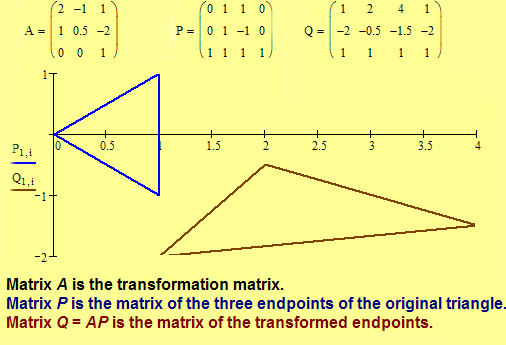3.2.3 Affine Transformation of the Euclidean
Plane
![]() Printout
Printout
A mathematician,
like a painter or a poet, is a maker of patterns. If his patterns are more
permanent than theirs, it is because they are made with ideas.
—![]() Godfrey Harold Hardy (1877–1947)
Godfrey Harold Hardy (1877–1947)
What is the form of a transformation matrix for the analytic
model of the Euclidean plane? We investigate this question. Let A = [aij]
be a transformation matrix for the Euclidean plane![]() and (x, y, 1) be any point in
the Euclidean plane. Then
and (x, y, 1) be any point in
the Euclidean plane. Then
.
Since the last matrix must be the matrix of a point in the
Euclidean plane, we must have a31x + a32y + a33
= 1 for every point (x, y, 1) in the Euclidean plane. In
particular, the point (0, 0, 1) must satisfy the equation. Hence, a33 = 1. Further, the points
(0, 1, 1) and (1, 0, 1) satisfy the equation and imply
a32
= 0 and a31 = 0,
respectively.
Therefore, the transformation matrix must have the form
,
which motivates the following definition.
Definition. An affine transformation of the Euclidean plane, T, is a mapping that maps each point X of the Euclidean plane to a point T(X) of the Euclidean plane defined by T(X) = AX where det(A) is nonzero and
where each aij
is a real number.
Exercise 3.19. Prove that every affine transformation of the Euclidean plane has an inverse that is an affine transformation of the Euclidean plane. (Hint. Write the inverse by using the adjoint. Refer to a linear algebra text.)
Proposition 3.3. An affine transformation of the Euclidean plane is a transformation of the Euclidean plane.
Exercise 3.20. Prove Proposition 3.3.
Click here to see
an animation of a sequence of affine
transformations.
Proposition 3.4. The set of affine transformations of the Euclidean plane form a group under matrix multiplication.
Proof. Since the
identity matrix is clearly a matrix of an affine transformation of the
Euclidean plane and the product of matrices is associative, we need only show
closure and that every transformation has an inverse.
Let A and B be the matrices
of affine transformations of the Euclidean plane. Since det(A) and det(B)
are both nonzero, we have that det(AB) = det(A)
· det(B)
is not zero. Also,
is a matrix of an affine transformation of the Euclidean
plane. (The last row of the matrix is 0 ,
0, 1.) Hence closure holds.
Complete the proof by showing the
inverse property.//
Exercise 3.21. Given three points P(0,
0, 1), Q(1, 0, 1), and R(2, 1, 1), and an affine transformation
T. (a) Find the points P' = T(P), Q'
= T(Q), and R' = T(R)
where the matrix of the transformation is . (b) Sketch
triangle PQR and triangle P'Q'R' . (c)
Describe how the transformation moved and changed the triangle PQR.
Exercise 3.22. Find the matrix of an affine transformation that maps P(0, 0, 1) to P'(0, 2, 1), Q(1, 0, 1) to Q'(2, 1, 1), and R(2, 3, 1) to R'(7, 9, 1).
Exercise 3.23. Show the group of affine transformations of the Euclidean plane is not commutative.
